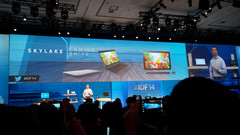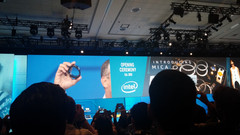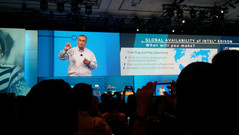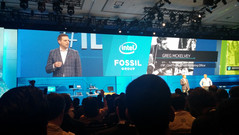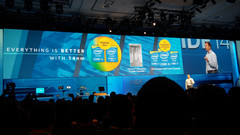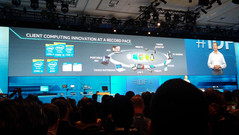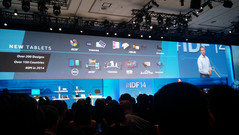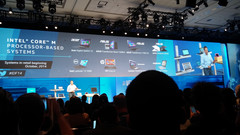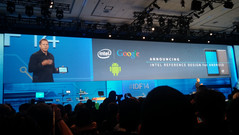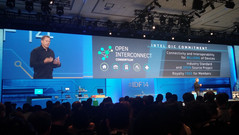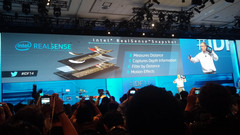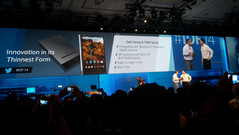"The Internet of Things" is the big idiom at this year's Intel Developer Forum kicking off this week at the City by the Bay. While not the catchiest of phrases, it explains the chipmaker's central plan very clearly: to integrate Internet or wireless communication capabilities into more "Things" ranging from wristwatches and earbuds to bracelets and brand name designer clothing. Whereas last year's conference opened up with a large focus on Haswell, this year's was noticeably less technical with a bigger picture on how upcoming Intel technology can have a place in everyday items.
Like last year, CEO Brian Kraznich was again first up on stage and almost immediately announced MICA, Intel's prototype luxury bracelet with a 1.6-inch touchscreen and a maturing partnership with both Fossil, Inc. and BioSport to integrate Intel chips into jewelry and handbags and earphones, respectively. Intel is expecting 50 percent of all mobile transactions to be from wearables like these by 2017.
With wearables out of the way, the second half of the keynote shifted gears to Intel's upcoming 14 nm Skylake architecture. Unfortunately, details were scarce and much of what was announced had already been known including its delayed Q2 2015 launch date. Intel demonstrated its 4K capabilities by running 3DMark Ice Storm live on stage and made note that there will be an increasing number of 2-in-1 devices with fanless designs because of Skylake and Core M advances. Other features like WiGig and wireless charging were also demonstrated to represent Intel's vision of a wire-free future and both are promised to be coming to Skylake.
Intel was mum in terms of specific models featuring the 14 nm SoC, but Kraznich did specify that there are currently 50 OEMs across 20 designs based on Core M. The Asus Chi detachable was a notable mention as the product has not been officially announced by the Taiwanese manufacturer at the time of writing.
After finishing up with Skylake and Core M, the keynote addressed Android directly and criticized its slow update schedule for most smartphones and tablets in the market. Any Android user will know this firsthand as waiting months for even a minor update is not uncommon. The newly announced Intel Reference Design for Android team will address this issue aggressively with a validation and update commitment of less than 2 weeks for qualified devices.
The keynote closed by reintroducing Intel's RealSense technology that was a small part of last year's opening talk. This time, however, the 3D camera was demonstrated live on an upcoming Dell Venue 8 7000 Series model, which is being boasted as the thinnest tablet to date at 6 mm with an 8.4-inch 2K resolution display. This particular model is launching this November in North America.
Assuming Intel follows through with its vision, we should be seeing Intel-powered clothes and personal items become as ubiquitous as smartphones in the near future. An increasing emphasis on wearables is essentially guaranteed for at least the next few years from chipmakers and computer manufacturers alike.


 Deutsch
Deutsch English
English Español
Español Français
Français Italiano
Italiano Nederlands
Nederlands Polski
Polski Português
Português Русский
Русский Türkçe
Türkçe Svenska
Svenska Chinese
Chinese Magyar
Magyar